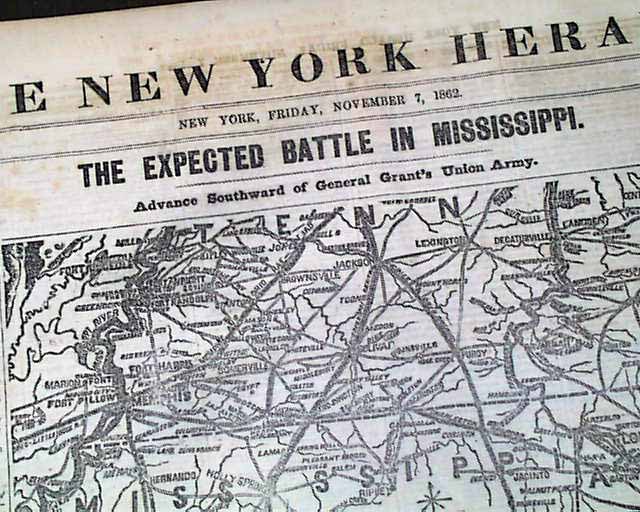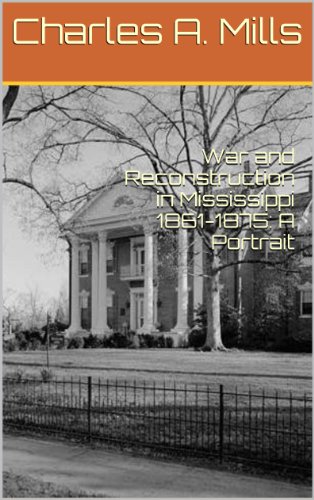
The book sat on a bookshelf in my parent’s bedroom for as long as I can remember. The shelf itself was a former window, occupied by an air conditioner when they became available in late 1950s New Orleans. When central air became possible, the window was reconfigured as a bookshelf.
The title of the book was The Battle of Liberty Place: the Overthrow of Carpetbag Rule in New Orleans, written by Stuart Omer Landry. It was printed by a local New Orleans publisher, Pelican Publishing, in 1955. This volume was apparently part of a numbered edition, except the number is left blank. If I remember correctly, a friend of my father’s at the publisher gave him a copy as a gift.

The book tells the story of a pitched battle that occurred in 1874, when New Orleans was still occupied by federal troops. On Sept. 14, 1874, some 5,000 armed citizens under the leadership of the Crescent City White League fought with the Metropolitan Police and state militia. The insurgents won the battle and held downtown New Orleans, including the statehouse and the armory, for three days. Federal troops arrived and restored the elected government.
The insurgent army drove the federal forces to take refuge in the Customs House on Canal Street (still in existence today), Eventually, after President Grant sent troops and gunboats, a truce was worked out. The siege ended and the insurgents dispersed with no one arrested.
I had always thought that the battle centered on Canal Street. It did, but it had also spilled over into the business district, including a part of Tchoupitoulas Street a scant half-block from where for some 20 years my father had operated his printing and mailing business on Gravier Street.
This “Battle of Canal Street,” as it has often been called, was the culmination of anger and violence that had started in different parts of the state with the disputed 1872 governor’s election. Both sides had claimed victory; the Democratic candidate likely won but the Republican candidate had the backing of federal troops. Both sides in the election had engaged in fraud and violence; a state panel appointed by the then-governor had declared the Democrat to be the winner.
Carpetbag rule in Louisiana and other places in the former Confederacy ended with the Compromise of 1877, in which Rutherford Hayes (the Republican) became president after the contested election with Samuel Tilden was resolved. In return for the House Democrats to vote for Republican Hayes, all federal troops were withdrawn from the South. And that was the end of Reconstruction, for good and for ill.

Some years later, a monument to the Battle of Liberty Place was erected on Canal Street near the Customs House; I remember walking by it numerous times. The monument was removed in 2017 in the wave of removal of Confederate monuments all over the southern states.
The account in the book is a rather frank celebration of the actions of the White League. The army, comprised primarily of Confederate veterans of the Civil War, is seen as patriots and defenders of liberty. The federal forces and the local police are treated far less favorably.
The book was a product of its time. The author, Stuart Omer Landry (1884-1966), was also the owner of Pelican Publishing. He had acquired the business in 1927, when it was part of the Pelican Bookstore on Royal Street in the French Quarter and included such patrons as William Faulkner and Sherwood Andrson. Landy also authored several other books, including The Caddo Indians: Their History and Culture, History of the Boston Club, and Dueling in Old New Orleans. Pelican was known for publishing books that advocated white supremacy and segregation, but it also published the first Louisiana Almanac in 1949 as well as other books of local history and culture.

After Landry died in 1966, Pelican was acquired by Hodding Carter, the Pulitzer- Prize-winning journalist. He owned it for three years, when it sold it to two brothers who returned it to its Landry-type orientation. In 2019, it was bought by Arcadia Publishing, eventually combined with River Road Press, and remained focused on more general historical and cultural subjects. (One of its titles in a family favorite: The Cajun Night Before Christmas, now more than 50 years old and sold in just about every souvenir shop in New Orleans.)
The Battle of Liberty Place is an artifact of its time. It’s profusely illustrated and isn’t strictly an anti-Union occupation screed. It includes considerable historical information. The first edition is listed for about $145; a paperback edition is also available for about $30.
I can’t recall my father ever talking about it, except to say the book was a gift. He may have done some general printing work for Mr. Landry, but, if so, that’s lost in time as well. When my mother was moving to an assisted living home in 2013, she told me to take whatever books I might be interested in. I took that on, as well as a few books he purchased about World War II and a biography of P.G.T. Beauregard, by historian T. Harry Williams and published by LSU Press, I had given him as a Christmas gift in 1970.
Top photograph: A drawing of the battle near the Customs House on Canal Street.









